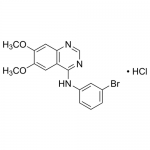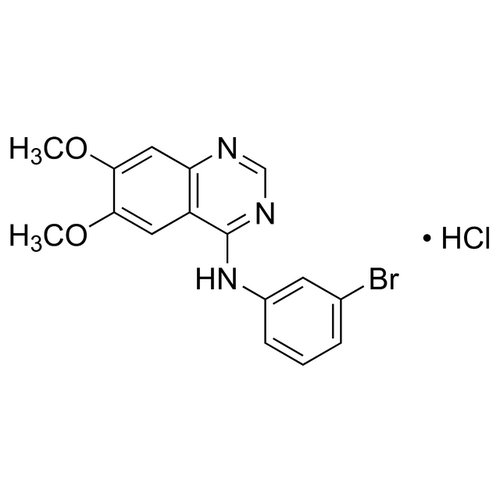| Product Name | AG 1517 |
| Description |
EGFR kinase inhibitor |
| Purity | >98% (TLC) |
| CAS No. | 153436-54-5 |
| Molecular Formula | C16H14BrN3O2 |
| Molecular Weight | 360.2 |
| Field of Use | Not for use in humans. Not for use in diagnostics or therapeutics. For in vitro research use only. |
Properties
| Storage Temperature | -20ºC |
| Shipping Temperature | Shipped Ambient |
| Product Type | Inhibitor |
| Solubility | Soluble in DMSO |
| Source | Synthetic |
| Appearance | White to off-white solid |
| SMILES | COC1=C(C=C2C(=C1)C(=NC=N2)NC3=CC(=CC=C3)Br)OC.Cl |
| InChI | InChI=1S/C16H14BrN3O2/c1-21-14-7-12-13(8-15(14)22-2)18-9-19-16(12)20-11-5-3-4-10(17)6-11/h3-9H,1-2H3,(H,18,19,20) |
| InChIKey | LSPANGZZENHZNJ-UHFFFAOYSA-N |
| Safety Phrases |
Classification: Acute toxicity, Oral (Category 3) Skin irritation (Category 2) Serious eye damage (Category 1) Specific target organ toxicity-single exposure (Category 3) Safety Phrases: S22 - Do not breathe dust. S24/25 - Avoid contact with skin and eyes. S36/37/39 - Wear suitable protective clothing, gloves and eye/face protection. Hazard statements: H301 Toxic if swallowed. H315 Causes skin irritation. H318 Causes serious eye damage. H335 May cause respiratory irritation Precautionary statements: P261 Avoid breathing dust/ fume/ gas/ mist/ vapours/ spray. P280 Wear protective gloves/ eye protection/ face protection. P301 + P310 IF SWALLOWED: Immediately call a POISON CENTER or doctor/ physician. P305 + P351 + P338 IF IN EYES: Rinse cautiously with water for several minutes. Remove contact lenses, if present and easy to do. Continue rinsing. |
| Cite This Product | AG 1517 (StressMarq Biosciences Inc., Victoria BC CANADA, Catalog # SIH-427) |
Biological Description
| Alternative Names | 4-[(3-Bromophenyl)amino]-6,7-dimethoxyquinazoline hydrochloride, AG 1517, PD 153035, SU 5271, ZM 252868, PD 153,035, SU 5271, 4-(3-Bromoanilino)-6,7-dimethoxyquinazoline |
| Research Areas | Apoptosis, Cancer, Cancer Growth Inhibitors, Cell Signaling, Tyrosine Kinase Inhibitors |
| PubChem ID | 4705 |
| Scientific Background |
AG 1517 is a potent and selective ATP-competitive inhibitor of the epidermal growth factor receptor (EGFR) tyrosine kinase. EGFR signaling plays a critical role in regulating cell proliferation, survival, and differentiation, and its dysregulation has been implicated in various pathological conditions, including cancer and neurodegeneration. In the context of neuroscience, EGFR is increasingly recognized for its involvement in neuroinflammatory responses, glial cell activation, and neuronal survival. Overactivation of EGFR pathways has been linked to oxidative stress and excitotoxicity—key contributors to the progression of neurodegenerative diseases such as Alzheimer’s and Parkinson’s. By selectively inhibiting EGFR, AG 1517 offers a targeted approach to modulating these detrimental signaling cascades. Moreover, EGFR inhibition may influence neurogenesis and synaptic plasticity, processes essential for cognitive function and brain repair. AG 1517’s cell-permeable nature enhances its utility in both in vitro and in vivo models, making it a valuable tool for dissecting EGFR-mediated mechanisms in the central nervous system. While originally developed for oncology, AG 1517 is gaining traction in neurobiology as a candidate for exploring therapeutic strategies aimed at reducing neuroinflammation, promoting neuronal resilience, and mitigating the molecular drivers of neurodegeneration. |
| References | 1. Kunkel M.W., et al. (1996) Investigational New Drugs. 13(4): 295–302. |



Reviews
There are no reviews yet.